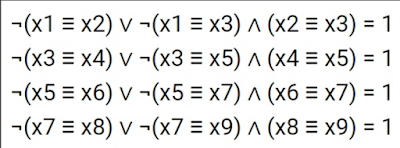"Poor understanding of Mapping Method (08.2016) is still a half of distress" B.D.
First of all be aware that intellectual property of approach been applied completely belongs to Helen Mironchick (unpublished manuscript ). See also PDF attachment to thread on USE in Informatics Polyakov's forum http://egekp.unoforum.pro/?1-6-0-00000120-000-0-0-1561979337 MEA's post 229. Posting below is nothing different from exercising technique proposed by MEA in mentioned PDF attachment targeting better understanding of solution been suggested in those thread.
We would consider a sample P149 and one more system which doesn't look as standard as P149 and requires a bit more experience in building 08.2016 diagrams.

((¬x1=>y1)^z1)≡((¬x2 v y2)=>z2)
((¬x2=>y2)^z2)≡((¬x3 v y3)=>z3)
((¬x3=>y3)^z3)≡((¬x4 v y4)=>z4)
((¬x4=>y4)^z4)≡((¬x5 v y5)=>z5)
Convert system to equivalent
((x1 v y1)^z1)≡((x2=>y2)=>z2)
((x2 v y2)^z2)≡((x3=>y3)=>z3)
((x3 v y3)^z3)≡((x4=>y4)=>z4)
((x4 v y4)^z4)≡((x5=>y5)=>z5)
Traditional solution ( classic version of Mapping Method as of 2013 ) might be found in my old blog entry http://mapping-metod.blogspot.com/2017/12/149-ege23pdf.html
Passing Polyakov's control

Consider a bit more complicated system
((x1 v y1)^z1)=> ((x2=>y2)=>z2)=1
((x2 v y2)^z2)=> ((x3=>y3)=>z3)=1
((x3 v y3)^z3)=> ((x4=>y4)=>z4)=1
((x4 v y4)^z4)=> ((x5=>y5)=>z5)=1
Now build diagrams required to solve updated problem with implications
First of all be aware that intellectual property of approach been applied completely belongs to Helen Mironchick (unpublished manuscript ). See also PDF attachment to thread on USE in Informatics Polyakov's forum http://egekp.unoforum.pro/?1-6-0-00000120-000-0-0-1561979337 MEA's post 229. Posting below is nothing different from exercising technique proposed by MEA in mentioned PDF attachment targeting better understanding of solution been suggested in those thread.
We would consider a sample P149 and one more system which doesn't look as standard as P149 and requires a bit more experience in building 08.2016 diagrams.

((¬x1=>y1)^z1)≡((¬x2 v y2)=>z2)
((¬x2=>y2)^z2)≡((¬x3 v y3)=>z3)
((¬x3=>y3)^z3)≡((¬x4 v y4)=>z4)
((¬x4=>y4)^z4)≡((¬x5 v y5)=>z5)
Convert system to equivalent
((x1 v y1)^z1)≡((x2=>y2)=>z2)
((x2 v y2)^z2)≡((x3=>y3)=>z3)
((x3 v y3)^z3)≡((x4=>y4)=>z4)
((x4 v y4)^z4)≡((x5=>y5)=>z5)
Traditional solution ( classic version of Mapping Method as of 2013 ) might be found in my old blog entry http://mapping-metod.blogspot.com/2017/12/149-ege23pdf.html
Passing Polyakov's control

Consider a bit more complicated system
((x1 v y1)^z1)=> ((x2=>y2)=>z2)=1
((x2 v y2)^z2)=> ((x3=>y3)=>z3)=1
((x3 v y3)^z3)=> ((x4=>y4)=>z4)=1
((x4 v y4)^z4)=> ((x5=>y5)=>z5)=1
Now build diagrams required to solve updated problem with implications
Passing Polyakov's Control






No comments:
Post a Comment